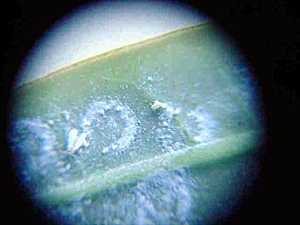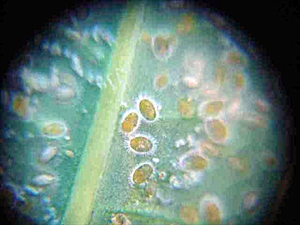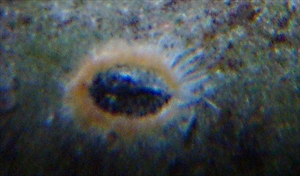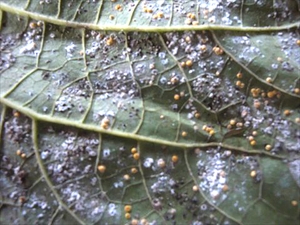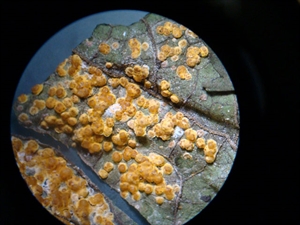Aleurotrachelus, Solanum whitefly or Capsicum whitefly.
Pacific Pests, Pathogens, Weeds & Pesticides - Online edition
Pacific Pests, Pathogens, Weeds & Pesticides
Capsicum Aleurotrachelus whitefly (168)
Aleurothrixus trachoides; previously, Aleurotrachekus trachoides.
Asia (India), South and Central America, and the Caribbean, with limited distribution in Africa. It is recorded from Australai (Torres Straits), Guam, Federated States of Micronesia, Fiji, Nauru, French Polynesia, and Tonga. There are reports of its presence in Solomon Islands and south coast of Papua New Guinea.
Common on plants in the Solanaceae (e.g., capsicum, chilli, eggplant, tobacco, tomato) and Convolvulaceae (morning glory, sweet potato) families. Also, avocado, brassicas, celery, citrus and cucurbits are hosts. In the Federated States of Micronesia, it is severe on capsicum, kava, Ixora and other ornamentals, and also on the vine, Merremia. In Palau, it is common on Duranta erecta (golden bush, golden dewdrop or pigeonberry).
The adult is similar to the more widespread spiralling white, Aleurodicus dispersus (see Fact Sheet no. 25), measuring about 1-2 mm in body length (Photo 1). Eggs are laid in a circle on the lower surface of young leaves (Photo 2). The larvae pass through four stages; the first ones walk short distances (or are blown in the wind), and are called 'crawlers'. These then settle, and the remaining three larval stages remain in the same place. The larvae are at first brown and then black and partly covered by thick cottony white filaments (Photos 3,4&5). The final larval stage is important for identifying whiteflies.
Aleurothrixus trachoides is not known to spread viruses.
Spread of the whitefly over short distances is on the wing or carried by the wind; over long distances it is associated with the domestic and international trade of fruits, leafy vegetables and ornamentals.
Damage is caused by the whitefly piercing the leaf and sucking the sap; this leads to early death of the leaf when whitefly numbers are high. Damage is also caused by build-up of sooty mould. Sooty moulds (fungi) grow on the honeydew produced by the whiteflies and their nymphs as they feed. The mould reduces sunlight reaching the leaves preventing photosynthesis and normal growth (see Fact Sheet no. 51).
Look for the white, winged adults on the underside of the leaves, and the circular egg masses. Look for the oval-shaped larvae, which are at first brown and later black. Look for the curly strands of wax produced by the larvae. It is said to be the only whitefly known to heavily infest Duranta species.
BIOSECURITY
Countries yet free from this whitefly and with similar climates to those where it is found should consider the pathways for its potential introduction. Attention should be given to the movement of fresh fruits and vegetables, and live plants from countries where the whitefly is present. Assessments should consider the suitability of conditions within glasshouses for establishment.
NATURAL ENEMIES
A minute wasp, Encarsia formosia, is well known as a biological control agent for this whitefly, and has been widely distributed. Several other Encarsia species have been reported to parasitise capsicum whitefly, and there are possibilites for biocontrol in other genera, too, e.g., Delphastus catalinae and Eretmocerus sp. Where the whitefly exists and is not being controlled, introduction of the parasotioids should be considered, following the guidelines of the UN/FAO. Fungi also attack the larval stages of Aleurotrachelus trachoides. The fungus, Aschersonia (probably Aschersonia aleyrodis), is common on the larvae of the whitefly in the Federated States of Micronesia (Photos 5-8). This fungus is easy to grow on artificial media and could be multiplied and sold to growers.
CHEMICAL CONTROL
While waiting for the introduction of parasitoids, as well as tests to make sure that they are effective and safe in the environment, an insecticide may need to be used. Soap, white or horticultural oil (see Fact Sheet no. 56), or a synthetic pyrethoid can be used. The treatments are best done when the whiteflies have hatched from the eggs or when still in the early larval stage, as they have soft bodies and are easily killed by insecticides. Synthetic pyrethroid insecticides are likely to kill natural enemies, so should be used with caution.
____________________
When using a pesticide, always wear protective clothing and follow the instructions on the product label, such as dosage, timing of application, and pre-harvest interval. Recommendations will vary with the crop and system of cultivation. Expert advice on the most appropriate pesticides to use should always be sought from local agricultural authorities.
AUTHOR Grahame Jackson
Information from Kumar V et al. (2016) Aleurotrachelus trachoides Back. Featured Creatures, Entomology & Nematology. UF/IFAS, University of Florida. (http://entnemdept.ufl.edu/creatures/veg/Aleurotrachelus_trachoides.htm); and CABI (2019). Aleurotrachelus trachoides. Crop Protection Compendium. (https://www.cabi.org/cpc/datasheet/4410); and Capsicum whitefly (2021) Business Queensland. Queensland Government. (https://www.business.qld.gov.au/industries/farms-fishing-forestry/agriculture/biosecurity/plants/priority-pest-disease/capsicum-whitefly); and from EPPO (2018) Mini data sheet on Aleurothrixus trachoides (Hemiuptera: Aleyrodidae). Photos 1-8 Konrad Engelberger, Pohnpei, Federated States of Micronesia.
Produced with support from the Australian Centre for International Agricultural Research under project PC/2010/090: Strengthening integrated crop management research in the Pacific Islands in support of sustainable intensification of high-value crop production, implemented by the University of Queensland and the Secretariat of the Pacific Community.

